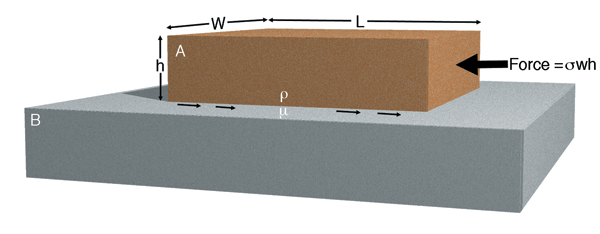Below is the online edition of In the Beginning: Compelling Evidence for Creation and the Flood,
by Dr. Walt Brown. Copyright © Center for Scientific Creation. All rights reserved.
Click here to order the hardbound 8th edition (2008) and other materials.
Can Overthrusts Occur? Can Mountains Buckle?
Slab A has a length, height, width, and density of L, h, w, and r, respectively. It rests on horizontal surface B and is pushed from the right. The pressure or force trying to move slab A over surface B exerts the maximum compressive stress, s, on the right end of slab A. Any compressive stress greater than s would crush slab A.
Let us make the very generous assumption that slab A is not bonded to slab B. Only static friction (with a coefficient m) at the A-B interface resists movement. For motion to occur, the pushing force must exceed the resisting force, that is:

Page 587 gives the values for g, m, and s. For rock

Therefore, Slab A will move only if

In other words, if a slab of rock is longer than 12.6 km (8 miles), the compressive stress trying to move A would exceed the rock’s maximum compressive strength, so the right end would crush before movement could begin. This result holds regardless of the slab’s other dimensions.
Conclusion: A rock slab longer than 8 miles cannot be pushed over unlubricated rock. Therefore, overthrusts would not occur in this way, nor could mountains buckle.
Because both can be seen to have happened in thousands of locations around the globe (for example, see Figure 49 on page 117), something lubricated the movement. The continental drift phase, which ended in the compression event, occurred under a global ocean at the end of the flood, so there was plenty of water available for lubrication.
The generous assumption that slabs A and B are not bonded together is automatically satisfied during the compression event, because the material in both slabs was deposited as water-saturated sediments during the flood.
Furthermore, the compression event created extensive layers of water, called liquefaction lenses, on which rock slabs quickly overrode other slabs with essentially no friction. [See "Liquefaction During the Compression Event" on pages 202–203.] This explains why rubble is usually missing from the sliding interface, and why geologist Clifford Burdick has reported that photographs of the interface between the two slabs show that sediments from the top slab were water deposited onto the bottom slab. [See Clifford L. Burdick, “The Lewis Overthrust,” Creation Research Society Quarterly, Vol. 2, September 1969, p. 96.]
Unlike the concentrated “applied force” acting on the right end above, which would have produced extreme internal stresses and crushing, no internal stresses occurred during gravity sliding downhill. This acceleration was driven by the rising Mid-Atlantic Ridge and the subsiding Pacific hydroplate. Crushing and buckling occurred (1) where the overriding slab was relatively weak or thin, (2) near points where the lubricant was first depleted, or (3) where an obstacle was encountered.
The hydroplate theory meets all these requirements, thereby explaining how overthrusting and buckling occurred. Within and hour (during the compression event), earth’s mountains formed in continental-size hydroplates.
